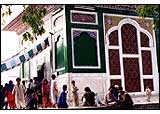 |
|
 |
After the
construction of Shahjahanabad, Shah Jahan's new capital at Delhi,
and the consequent eclipse of Lahore, traffic along the Grand
Trunk road returned to its earlier southeasterly alignment from
the Delhi Gate of the Walled City. This southeastward alignment,
marked in Mughal times by kos minars (distance-markers),
persisted until the Sikh conquest of Punjab, which made the northeasterly
route to and from Lahore to the holy city of Amritsar important
again

|
 |
Dara
Shikoh with
Mian Mir and Mulla Shah
|
|
|
|
|
|
One
of the key settlements along this southeasterly alignment, in the
farthest suburbs of Lahore, was a community known as Mian Mir,
named for the famous Sufi saint buried there in 1635. The Mian Mir
area acquired special spiritual significance for the Mughal dynasty
during the governorship of Prince Dara Shikoh, who sought advice
from Mulla Shah, a disciple of Mian Mir. Over time, the sites established
in the Mian Mir area achieved a remarkable synthesis of Mughal and
Sufi tradition. |
 |
Devotees
at Mian Mir Site
|
 |
|
|
|

The central site in this area is naturally the shrine of Mian Mir.
The shrine is square in shape, green in color, and elevated above
the stone courtyard. On Thursday evenings and the `urs (death-day
anniversary) of Mian Mir it has hundreds of devotees, qawwali
singers, drummers, and harmonium players. The courtyard has entrances
to the north and south with a mosque on its western side. To the
east, within the courtyard, lie graves of close relatives and disciples,
while an expansive graveyard extends to the south and west outside.
 |
|
|
Further
east, on axis, is the tank and tomb of Nadira Begum. Despite numerous
traditions to the contrary, Nadira Begum was a wife of Dara Shikoh.
She was buried in a tank-pavilion which resembles a garden in some
respects and the Hiran Minar in others. Today the tomb appears to
be set within a garden, but it was originally situated in a tank
much like that at the Hiran Minar in Sheikhupura. The tank was exactly
200 by 200 Mughal gaz in size. The "tomb" has the form of a central
square pavilion which faces due west toward the shrine of Mian Mir.
As at Nur Jahan's tomb, Nadira Begum's pavilion has an open character
and may have been converted to a tomb after her death. Mulla Shah
also built the famous Pari Mahal school-garden in Kashmir.
 |
|
|
To the south
of the shrine of Mian Mir is a large graveyard (qabristan)
with diverse notables including one Nateh Shah, who had special
powers with respect to weather and meteorological phenomena (e.g.,
rain). Of great relevance to the subject of Mughal garden history
is the shrine-garden of Mulla Shah, further to the west. Mulla
Shah was a disciple of Mian Mir and spiritual preceptor of Prince
Dara Shikoh, who built the tomb-garden for this saint in what
constitutes a very rare example of synthesis between Sufi and
Mughal tomb-garden design.
Conservation
Update: Several quadrants of the Nadira Begum complex
have been landscaped. Although the plantings were not based on
archaeological sources, the population of Lahore enjoys the shade,
flowering shrubs, and grass lawns at the site. The Mian Mir tomb
complex is well-maintained on account of its spiritual significance,
as is the Mullah Shah tomb-garden. A marble apron has been added
around the tomb, and the ablution area has been finished with
glazed tiles.
|
 |
 |
 |
 |
|